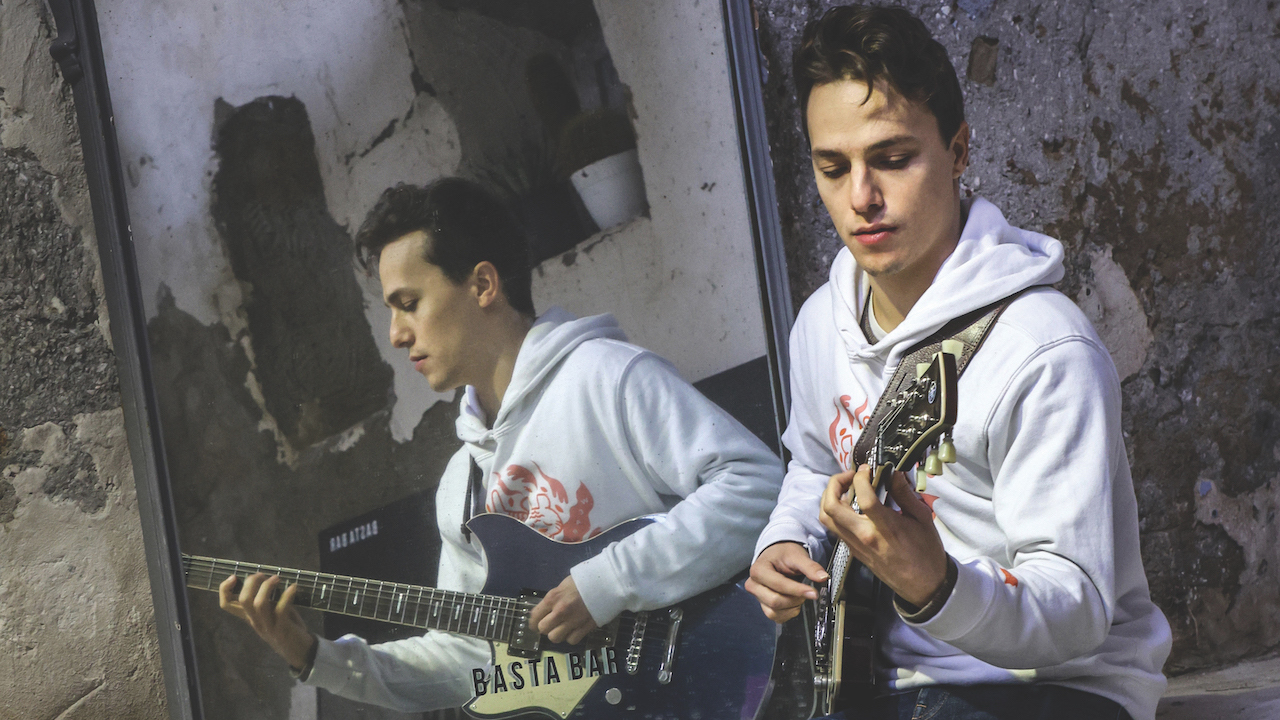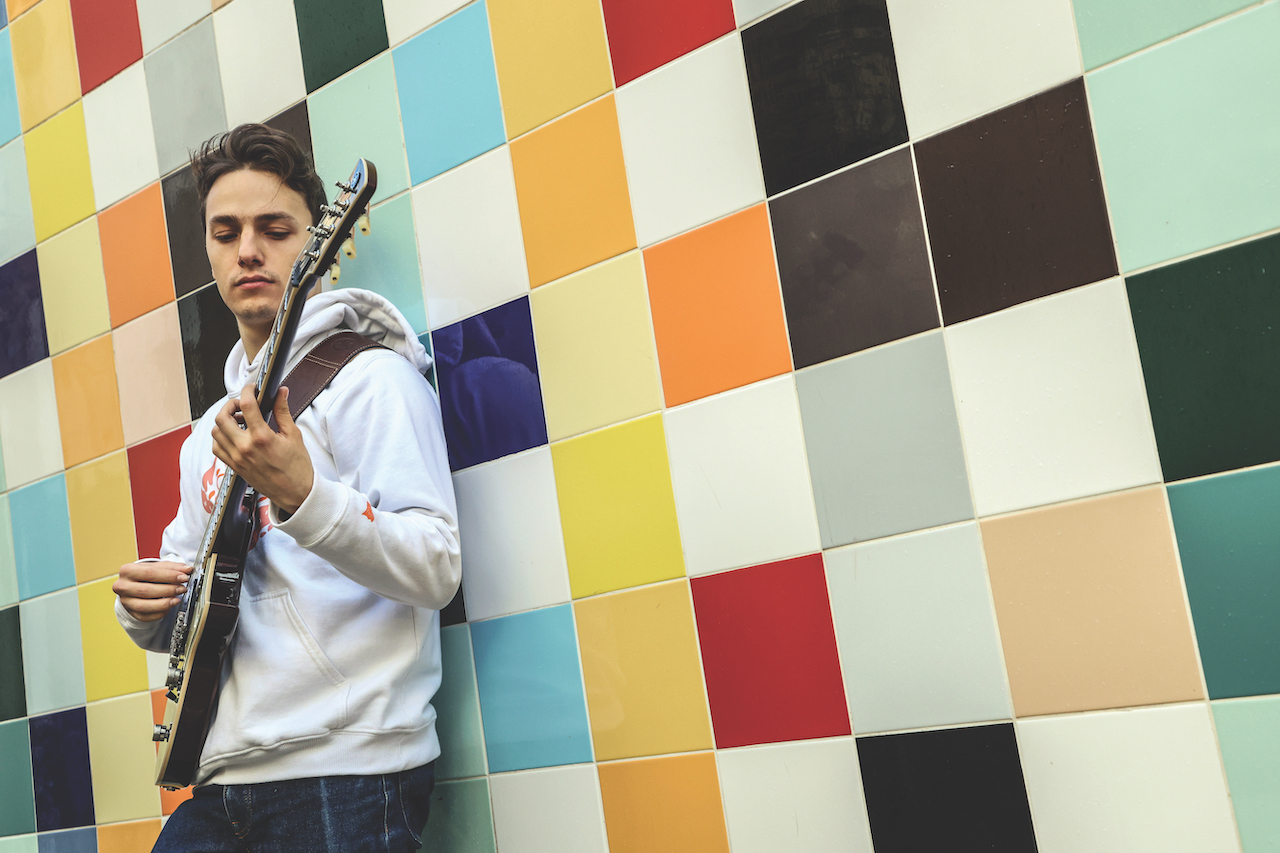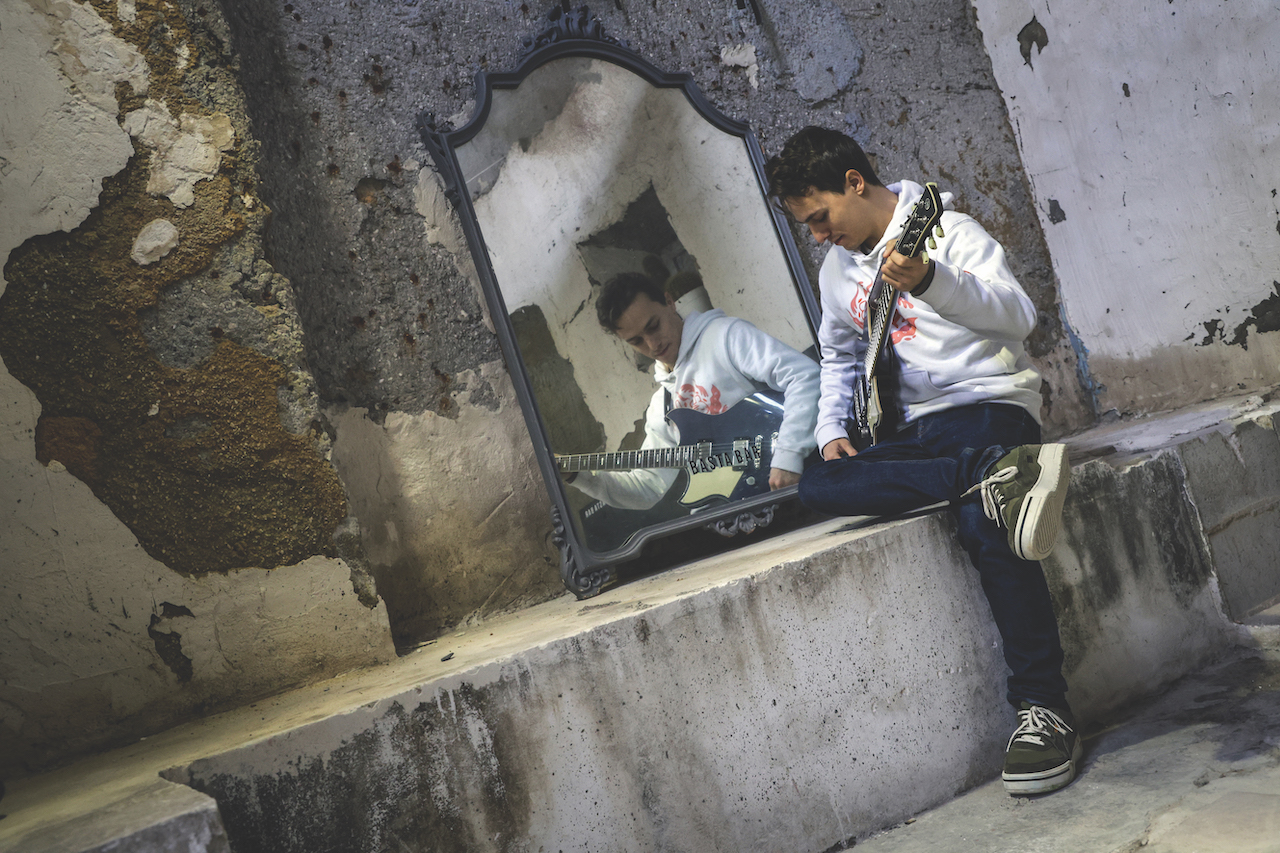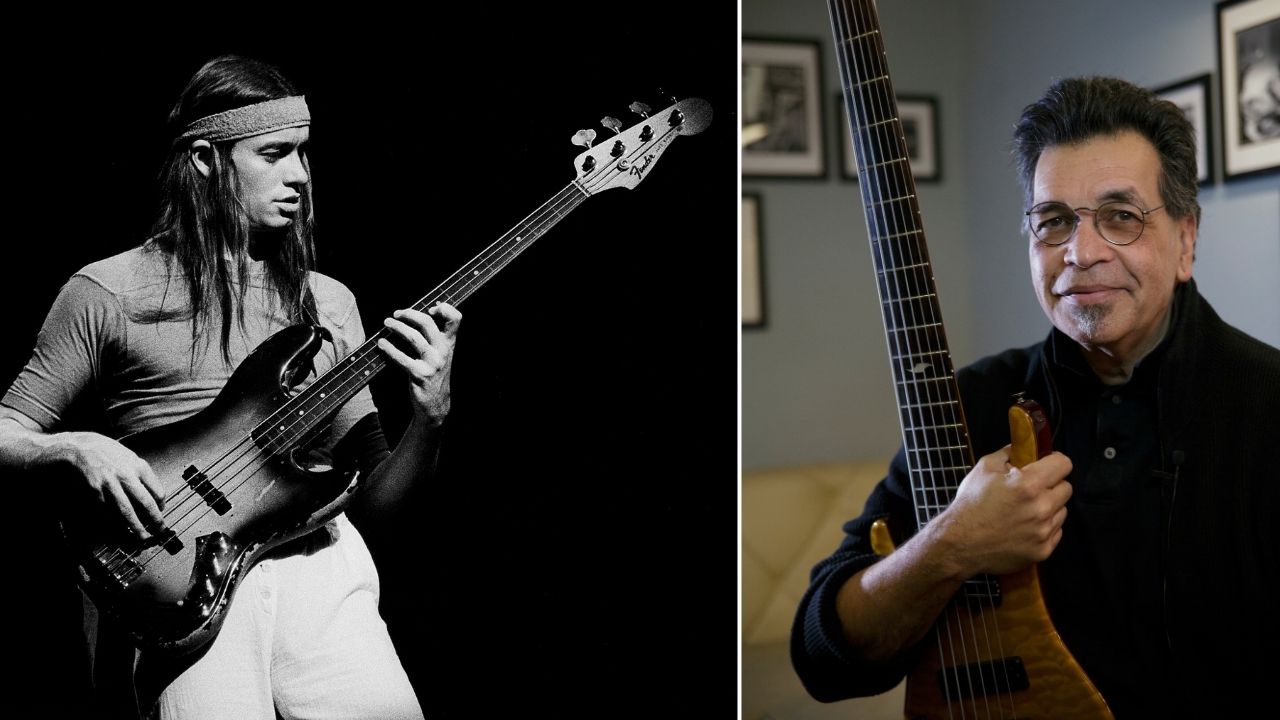“I find Les Pauls too heavy – they’re not comfortable to play! I just stick with the Yamaha models because of the sound and the relationship I have with them”: Matteo Mancuso talks tone, technique and Guthrie Govan’s key to improvising
The Sicilian guitar prodigy discusses the fingerstyle techniques, arpeggios and gear choices that have made him one of the most exciting names in modern guitar

No one has lit up the guitar community – excluding Nuno Bettencourt with his breathtaking Rise guitar solo last year – quite like Matteo Mancuso. The 27-year-old Sicilian released his first album, The Journey, last summer and would be the first to admit his life has become a bit of a blur ever since, from the onslaught of tutorial videos dissecting his fingerstyle method to ending up as the most talked about musician at this year’s NAMM Show.
And although it’s his technique that will undoubtedly be responsible for forging a lot of those unforgettable first impressions, hitting the same speeds Paul Gilbert and Al Di Meola are known for using just his fingers, it’s the sheer sense of musicality that makes his debut full-length such an electrifying listen from beginning to end.
There are moments of unbelievable virtuosity that nod to jazz fusion masterminds like Guthrie Govan and Greg Howe packed alongside the melodic grace one might associate with Eric Johnson and the avant-garde tension typified by Pat Metheny. In that sense, the Palermo-born Yamaha endorsee is very much the full package. And this is just the start of his journey.
Like many rock players, it was the era-defining works of Jimi Hendrix, Ritchie Blackmore and Jimmy Page that first caught the guitarist’s ear. Mancuso’s techniques, however, were inherited serendipitously – the result of growing up around a musician father who’d often play nylon-string acoustics at home.

“I started out on electric because I actually wasn’t too interested in classical,” the rising star says with a nervous laugh. “But when I was young I always saw my dad playing classical acoustic. I ended up with a strange combination – playing electric but with my fingers, because I thought that’s how you’re supposed to play. When I started, I wasn’t really into jazz.
“My father helped me more like a listener than a teacher. His job was to drag me back in time and go back to the source material. Django Reinhardt ended up becoming one of my favorite players, and I soon discovered that a lot of modern rock players were borrowing ideas from jazz traditions. Everything was connected, in a way, which is how I ended up blending those influences into my own style.”
What were the defining qualities in Reinhardt’s playing that inspired you?
All the latest guitar news, interviews, lessons, reviews, deals and more, direct to your inbox!
“It wasn’t so much about the scales. It was the sense of storytelling to his solos. That’s what I got out of it. He could take small pieces of information and make them beautiful, you know? If you analyze his solos, there’s not really a lot of scales or chords. His leads are usually very simple, with some arpeggios. There’s nothing fancy going on, but he had this tone and touch. There was a control he had over the melodic information that he chose to share.
“That’s actually the most difficult thing to learn in terms of improvising. His melodies were very effective and very simple. Just listen to All of Me or Minor Swing. They’re not harmonically rich. Another player with the same gift was Wes Montgomery. He could improvise and make it sound like the part was pre-written. That’s why they’re some of the best players ever, at least for me.”
The goal for me was not to play fast, but to play as accurately as possible. I wanted everything to sound clean rather than fast from the very start
You were only 16 when you uploaded your first video to YouTube, a fingerstyle cover of Racer X’s Technical Difficulties played on a Gibson SG.
“I’m still not satisfied with how it came out. The sound was bad and the playing wasn’t that good. But at the time I was in a competitive mode. I wanted to learn other people’s things and demonstrate that I was able to do it. Technical Difficulties felt like a big challenge, especially using just my fingers.”
Then you started dabbling in the relentless rhythms of country rock, taking on Brent Mason’s Pick It Apart and Guthrie Govan’s Rhode Island Shred. Again, pieces that are not for the faint of heart.
“It was just a matter of time in terms of speed. I still practice a lot these days. The goal for me was not to play fast, but to play as accurately as possible. I wanted everything to sound clean rather than fast from the very start. The country stuff wasn’t as hard to learn for me because those players use a lot of hybrid picking, which is similar to my fingerstyle approach. Some licks felt familiar just because of that chicken picking technique. People like Brent Mason and Johnny Hiland are incredible at that.
“And like the gypsy jazz stuff, I wanted to absorb the vocabulary rather than just absorb the technique. If you understand the vocabulary you can improvise better. I learned a lot of solos to get there. A perfect example of a player who can do everything is Guthrie Govan. He’s so versatile, and it was actually him who turned me on to that approach. After him, I learned about Brent, Johnny and the other country pickers.”
You also covered Pat Metheny’s Have You Heard, which feels closer to your own style. What did you pick up from him?
If you like having an amp behind you, go with that... But if you’re more worried about the consistency of your tone, digital gear these days is incredible
“Pat is one of my favorite composers. Anytime I’m composing with a classical guitar, he’s a really big influence – maybe too much! He’s an incredible player. I think he peaked with the Pat Metheny Group; those are some of his most memorable tunes.
“Still Life (Talking) [1987], for example, is one of my favorite albums of all time. When I first started working on jazz phrasing, there were a lot of chromatic passages that I stole from Pat, particularly the song Have You Heard. I got a lot from that one tune! I also love his clean tone; it’s very mellow.”
You utilize two fingerstyle positions: appoggiato, where the picking hand is supported, and tocco libero, where it is not.
“When I’m trying to do something like Technical Difficulties, basically three-notes-per-string ’80s shred stuff, I tend to play more with the appoggiato technique, where the thumb is supported on the string and three fingers pick each note independently.
“It’s a mix of flamenco and bass techniques, because bass players use the same kind of position. Anything that’s more scale-oriented, including pentatonic stuff, will be played that way.
“For arpeggios, tocco libero is more like the classical technique, with my wrist in line, which means my thumb is available. I never use my pinky, actually, so I only have nails on three fingers and the thumb. And the three nails on my fingers aren’t real; I use a product called gel nails. You put them on your real nails and they’re actually way stronger. My thumbnail is real, mainly because I don’t use it as much as the three fingers.”
Jeff Beck is a huge influence whenever I’m using the bar. Nobody can sound like him; it’s impossible
Silkroad is one of the more well-known tracks from your record. Interestingly, you chose to use a Yamaha Pacifica on that one.
“The Pacifica is the best Strat you can buy at that price in terms of quality. I think they sound great. And now they have the Professional models, which are supposed to be very good, though I haven’t actually tried one yet. For the second album, I’d like to do more songs like that, with the whammy bar.
“Of course, Jeff Beck is a huge influence whenever I’m using the bar. Nobody can sound like him; it’s impossible. There was only one Jeff Beck, and there will only ever be one.”
Samba Party is less moody and more of a major-key fusion jam.
“That’s actually one of my favorite tracks. I wanted to write a happy major song, with a lot of those chords. It’s one of the brightest songs on the album. Some of the lines in the solo were stolen from Greg Howe, particularly the tapping stuff. It doesn’t actually have anything to do with samba, funnily enough, except for the theme. But it sounded like a fun name to me. I can’t really label that song; it’s not rock, fusion or jazz.”
You tend to use simpler melodies over complex chord progressions, like on Falcon Flight, or more complex lines over more straightforward progressions. It’s all about balance, right?
“That’s how I think about all composition in general. You need to have balance. Complex chords call for simple melodies. And then with the simpler movements, you can experiment more with intricate melodic ideas. I used my dad’s old Roland VG88 on that song for the sitar parts. I really like that sound and wanted to do an intro with a fadeout. It’s the shortest song on the album, so I wanted to do something special.”
How much do you think about theory when improvising or composing solos?
“When I visualize the notes on the fretboard, I prefer to focus on the chords rather than the scales. A good way to look at it is to harmonize your scales. Take a major scale, for example. I like to have all seven modes available and divide the neck into seven different positions. If I’m playing in A minor, I can think about E minor or C major. I try to think about all the degrees of the scale, of the key. If I want to go outside, I will think about another scale in that key.
“On Silkroad, I was thinking of Phrygian dominant in F# or the diminished scale. I like the half-whole iteration of that scale in particular. Sometimes I use a bit of melodic minor as well. But it all gets related to a chord; that’s very important for me.”
What would you say is the most difficult to play lick on the record?
“I’d have to listen to it again! I think there’s a part of Silkroad that’s really challenging. There are crazy licks everywhere, to be honest. The Blues for John solo wasn’t easy. I wrote that song in tribute to John McLaughlin after falling in love with his work in Mahavishnu Orchestra and on the Friday Night in San Francisco album with Al Di Meola and Paco De Lucía.
“I wanted to outline the changes but also rock out. When you’re shredding, you tend to do it in one scale, but on a song like that, the chords are changing so you have to keep an eye on them. It was quite tricky, but it’s also a bluesy song, so there are a lot of those Joe Bonamassa and Eric Johnson-style ideas.
It’s not like I’ve been told I can’t use Fenders or Gibsons, but I think it’s better behavior for me to stick with Yamahas for my videos
“Polifemo is difficult as well, especially live because it really needs another instrument like a piano to do the chords. I think it’s one of the songs that suffers from the trio setup of my band – it brings a lot of freedom, but songs like that need a harmonic background that you can’t quite get with a trio.”
You recorded most of the album with a Yamaha Revstar Custom fitted with Lollar Imperial humbuckers. What is it about that guitar and those pickups that speak to you?
“It’s my go-to guitar for everything. It sounds amazing and is very reliable. That’s what I brought with me for my first American tour. To be honest, the Lollar pickups were already fitted. I’m not much of a nerd when it comes to pickups. I just liked the sound and didn’t need to change them. But there was a set I tried at NAMM that I ended up loving – the PAF 59s by DiMarzio.
“I thought they sounded incredibly good. I don’t want much output on my neck pickup because I only use it for clean sounds. I don’t use it for distorted tones because it’s too muddy and dark; I just use the bridge for overdriven sounds. That DiMarzio seemed to really do the job. It’s a pickup I’m really interested in.”
You used your dad’s old sunburst Strat on some of the rhythm parts. What can you tell us about it?
“I think it’s just a standard American Strat that my father bought in the ’70s, but the guitar itself was made in the ’60s. I think the year is 1968, so it’s a very old guitar. I really like the second and fourth positions on the pickup selector for rhythm parts. I have tons of guitars at home, and most of them are from my father.
“I use the Revstar and Pacifica most of the time — and there’s also a Ramirez classical guitar. But there’s plenty of other things to choose from. There’s a goldtop Les Paul Deluxe with mini humbuckers and a Black Beauty that now has yellow binding from years of aging. Both are from the ’70s.
“I find Les Pauls too heavy; they’re not comfortable to play! I just stick with the Yamaha models because of the sound and the relationship I have with them. There are no restrictions with other guitars; it’s not like I’ve been told I can’t use Fenders or Gibsons, but I think it’s better behavior for me to stick with Yamahas for my videos.”
You swear by digital gear live and in the studio, mainly trusting in your Line 6 Helix. Does it all boil down to reliability?
“Yeah! Digital amp modeling is so much more reliable. I’m a lazy guy; I don’t want to use tube amps. Of course, sometimes they can sound incredibly good and way better than the simulations. But the advantage of digital is that you can combine different things, like two amps – or all these extra effects – without problems.

“That’s why I like to have an all-in-one pedalboard that covers all my sounds. The tone is exactly the same for every gig. You can’t do that with a real amp, especially if you are renting them – you have no idea what you might find and what condition it will be in. That’s a big issue for me.
I think the main difference between analog and digital isn’t the sound – sometimes I can’t really tell the difference – but rather the experience on stage
“I think the main difference between analog and digital isn’t the sound – sometimes I can’t really tell the difference – but rather the experience on stage. If you like having an amp behind you, go with that. For some players that’s important. Digital amps can’t replace that feeling. But if you’re more worried about the consistency of your tone, digital gear these days is incredible.”
Could that change? Say in five years time, you’re playing bigger venues and starting to experience more high-end touring with the personnel to take care of everything… Will we ever see you switch to a multiple-amp rig like Eric Johnson or Joe Bonamassa?
“I don’t know, to be honest, because I’m so comfortable with what I have now. I’m the kind of person who sticks with what feels easiest and most comfortable. And you have to remember digital amps will continue to get better and better.
“The only way it might change is if I find an amp that cannot be replicated at all through digital technology. That would be the point where it could all change, but it hasn’t happened yet.”

You clearly have a very strong knowledge of arpeggios across the fretboard. Which ones do you find yourself using the most?
“Most of them aren’t particularly strange, they’re just the common ones we all use. But I have a few tricks to sound unique. If we’re in A minor, instead of playing an A minor 7 arpeggio (A, C, E, G), I’ll play a C major 7 arpeggio (C, E, G, B) starting on an A note.
“That would be the 5th and 8th frets on the low E string, the 7th fret on the A string, the 5th and 9th frets on the D and G strings, then the 8th fret on the B and 7th on the high E. So it’s more like A minor 9, which is a sound I really like.
“That’s a good trick. I find it more interesting than the usual minor and major arpeggios. Another trick I use a lot is the pentatonic scale but with some 5th intervals removed.
“If you’re in E minor, it would be something like the 7th and 10th frets on the A string, the 7th on the D, the 7th and 9th on the G, the 10th on the B and then the 7th and 12th frets on the high E. I’ll play lines like that in various positions across the neck. It has a different flavor compared to regular pentatonic ideas.”
Legato lines can often feel very loose and free, but a lot of your ideas have a strong rhythmic backbone, similar to British fusion guitarist Tom Quayle.
“It’s been quite difficult to achieve that. I’ve worked hard on my left hand because I believe it to be more important than my right. It’s responsible for the tone, bending, vibrato and more. If you have a bad left-hand technique, you won’t sound that good. I like to keep my left hand relaxed and use a lot of legato. I actually don’t like the sound of everything picked, at least in most situations.
“On acoustic, however, there isn’t sustain like an electric guitar. That’s probably when I’d choose to fingerpick every note. Using distortion on an electric means I can use a lot more legato. I love players like Allan Holdsworth and Tom Quayle, who are very legato-led.”
What can we expect from album number two?
“I will use my Pacifica more on the next album. I love the single-coil sound and the whammy bar. It will probably be less jazz-oriented and more like free composition. I love Pat Metheny’s approach to harmony, so it will be more in that direction. But I can’t say for sure... that’s the beauty and the mystery of a second album.”
- For more information and tour dates, head to Matteo Mancuso’s site.
Amit has been writing for titles like Total Guitar, MusicRadar and Guitar World for over a decade and counts Richie Kotzen, Guthrie Govan and Jeff Beck among his primary influences as a guitar player. He's worked for magazines like Kerrang!, Metal Hammer, Classic Rock, Prog, Record Collector, Planet Rock, Rhythm and Bass Player, as well as newspapers like Metro and The Independent, interviewing everyone from Ozzy Osbourne and Lemmy to Slash and Jimmy Page, and once even traded solos with a member of Slayer on a track released internationally. As a session guitarist, he's played alongside members of Judas Priest and Uriah Heep in London ensemble Metalworks, as well as handled lead guitars for legends like Glen Matlock (Sex Pistols, The Faces) and Stu Hamm (Steve Vai, Joe Satriani, G3).








